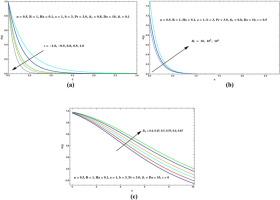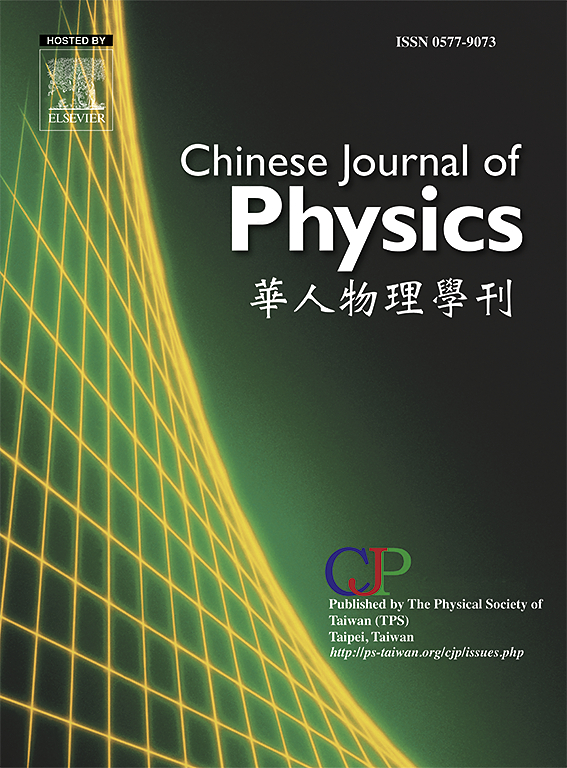辐射和滑移影响多孔表面微极流体动力学的精确公式和解
IF 4.6
2区 物理与天体物理
Q1 PHYSICS, MULTIDISCIPLINARY
引用次数: 0
摘要
目前的研究对流体在可变形多孔表面上流动时的速度滑移的复杂行为进行了详尽的分析,这些行为受到均匀和逐渐升高的热条件的影响。利用边界层近似和相似变换,将基本控制方程重新表述为耦合非线性微分方程组。这些方程是精心解决,以获得精确的解决方案,捕捉细微的相互作用之间的传热和流体动力学跨越广泛的物理显著参数。这些解决方案的存在性、唯一性或多样性关键取决于传质速率和微极流体效应等关键变量。具体来说,传质参数作为一个阈值,划定了解可能存在或不存在的条件。对于拉伸曲面,可以确定一个奇异解,而对于收缩曲面,可以观察到多个不同的解。此外,该研究深入研究了在选定参数情景下传热和流体流动行为的精确解,提供了关键变量的封闭形式表达式,包括皮肤摩擦,转速,热流密度,流体速度和约化努塞尔数。这些表达式通过详细的图形表示进一步可视化,揭示了控制流动状态的关键物理现象。该研究的主要发现表明,微观结构效应显著增强了流体的旋转行为,而热辐射显著改变了表面附近的温度分布。滑移条件导致边界层变薄,影响热量和动量传递速率。这些见解在高级绝热、微流体、生物医学流动和涉及多孔结构的能源系统等领域具有实际意义。本文章由计算机程序翻译,如有差异,请以英文原文为准。

Exact formulation and solution of micropolar fluid dynamics in radiative and slip-influenced porous surface
The current investigation offers an exhaustive analysis of the complex behaviour of velocity slip in a fluid flow over a deformable porous surface, subject to both uniform and progressively elevated thermal conditions. Through the utilization of boundary layer approximations and the application of similarity transformations, the fundamental governing equations are reformulated as a system of coupled nonlinear differential equations. These equations are meticulously solved to derive exact solutions that capture the nuanced interplay between heat transfer and fluid dynamics across a wide spectrum of physically significant parameters. The existence, uniqueness, or multiplicity of these solutions hinges critically on key variables such as mass transfer rates and micropolar fluid effects. Specifically, the mass transfer parameter serves as a threshold, demarcating conditions where solutions may either exist or fail to emerge. In the case of a stretching surface, a singular solution is identified, while for a contracting surface, multiple distinct solutions are observed. Moreover, the study delves into exact solutions for heat transfer and fluid flow behaviour under select parametric scenarios, offering closed-form expressions for pivotal variables including skin friction, rotational velocity, heat flux, fluid velocity, and the reduced Nusselt number. These expressions are further visualized through detailed graphical representations, shedding light on the key physical phenomena governing the flow regime. Key findings of the research reveal that microstructural effects significantly enhance the rotational behaviour of the fluid, while thermal radiation notably alters the temperature distribution near the surface. Slip conditions lead to thinner boundary layers, affecting both heat and momentum transfer rates. These insights have practical implications in areas such as advanced thermal insulation, microfluidics, biomedical flows, and energy systems involving porous structures.
求助全文
通过发布文献求助,成功后即可免费获取论文全文。
去求助
来源期刊

Chinese Journal of Physics
物理-物理:综合
CiteScore
8.50
自引率
10.00%
发文量
361
审稿时长
44 days
期刊介绍:
The Chinese Journal of Physics publishes important advances in various branches in physics, including statistical and biophysical physics, condensed matter physics, atomic/molecular physics, optics, particle physics and nuclear physics.
The editors welcome manuscripts on:
-General Physics: Statistical and Quantum Mechanics, etc.-
Gravitation and Astrophysics-
Elementary Particles and Fields-
Nuclear Physics-
Atomic, Molecular, and Optical Physics-
Quantum Information and Quantum Computation-
Fluid Dynamics, Nonlinear Dynamics, Chaos, and Complex Networks-
Plasma and Beam Physics-
Condensed Matter: Structure, etc.-
Condensed Matter: Electronic Properties, etc.-
Polymer, Soft Matter, Biological, and Interdisciplinary Physics.
CJP publishes regular research papers, feature articles and review papers.
 求助内容:
求助内容: 应助结果提醒方式:
应助结果提醒方式:


